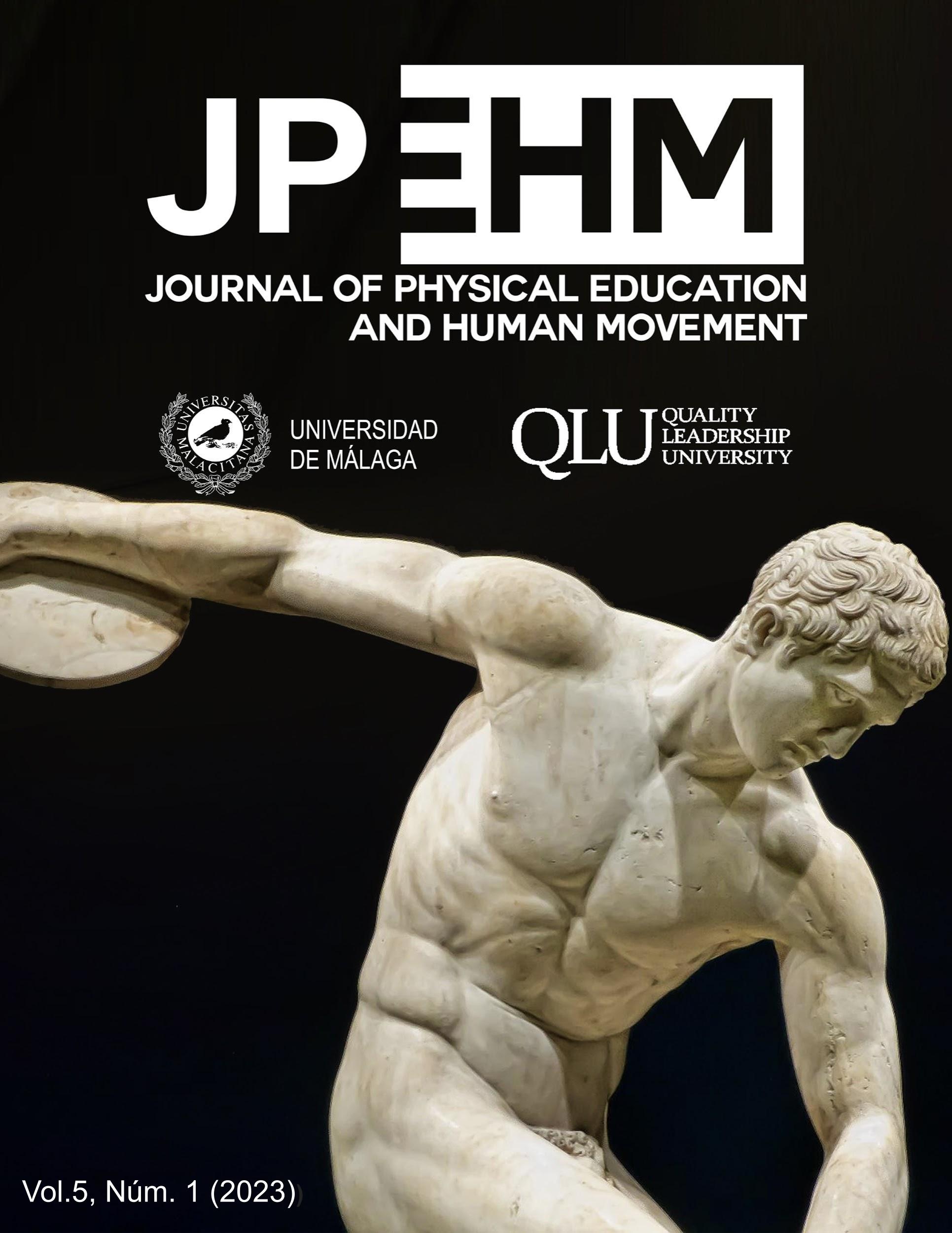Español The expressive creation of the body through music in compulsory secondary education
Español
DOI:
https://doi.org/10.24310/JPEHMjpehmjpehm.v5i115832Keywords:
creativity, expression, experiential, comprehensive learningAbstract
In the didactic intervention that is presented, the expressive corporal creation is developed in the students of the second year of Compulsory Secondary Education, which starts from the search for musical and expressive corporal resources, where hearing and corporal expression converge, in addition to the knowledge of musical language. as a learning process.It is developed with a sample of 90 students from the same educational center. The objective of the educational experience was to promote capacities, abilities, attitudes and creative aptitudes through corporal expression. It is carried out through an active, cooperative methodology, in three class groups, where flexible groupings are used that favor enrichment among the students. The evaluation tool has been a rubric. Throughout the didactic intervention, data is collected from each class group in the experiential phase, deepening phase and in the creative expression phase. In the conclusions obtained, it can be deduced that the creation of corporal expression through music is currently presented as necessary to promote creative development, through didactic interventions in which experiential, comprehensive and quality learning is encouraged.
Downloads
Metrics
References
Bernal, J. (2009). Música y creatividad. Creatividad y música. Revista Creatividad y Sociedad, 13, 1-8. http://creatividadysociedad.com/wp-admin/Art%C3%ADculos/13/Creatividad%20y%20Sociedad.%20Creatividad%20y%20Educacion%20Musical.pdf?_t=1576011905
García Acevedo, M. (1964). Didáctica musical. Ricordi Americana.
Gil Frías, P.B. (2009). Estimular la creatividad en la clase de música. Pautas de interacción docente. Revista Creatividad y Sociedad, 13, 52-79. http://creatividadysociedad.com/wp-admin/Art%C3%ADculos/13/Creatividad%20y%20Sociedad.%20Que%20es%20y%20que%20entendemos%20por%20aprernder%20musica.pdf?_t=1576011934
Giráldez, A. (2007). La composición en el aula de música. En Aróstegui, J.L. et al. La creatividad en la clase de música: componer y tocar. Revista Claves para la innovación educativa, 40, 27-33. Editorial Graó.
Hernández, E.M. (1998). Creatividad y autores creativos. En Marín Ibáñez, R; López-Barajas Zayas, E. y Martín González, M.T. (coords.). Creatividad polivalente. Actas y Congresos. 209-212.
Jiménez Vicioso, J.R. (2006). Proyecto curricular investigando nuestro mundo (6-12). Un aula para la investigación. Díada.
Jimeno García, Mª. (2000). La música: del arte a la educación. Música y educación, 41,15-28. Musicalis.
Johnson, D. W., Johnson, R. T., y Holubec, E. J. (2014). Los nuevos círculos de aprendizaje: La cooperación en el aula y la escuela. Aique, S.A.
Kanellopoulos, P.A. (2012). Envisioning Autonomy through Improvising and Composing: Castoriadis visiting creative music education practice. Educational Philosophy and Theory, 44 (2), 151-182. https://www.academia.edu/es/5329251/Kanellopoulos_P_%CE%91_2012_Envisioning_Autonomy_through_Improvising_and_Composing_Castoriadis_visiting_creative_music_education_practice_Educational_Philosophy_and_Theory_44_2_151_182
Langeveld, J. (2002). Escuchar y mirar. Teoría de la música. Ediciones Akal.
Logan, L. M. y Logan, V. G. (1980). Estrategias para una enseñanza creativa. Oikos-tau.
López, G. y Acuña, S. (2018). Aprendizaje cooperativo en el aula. Inventio, la génesis de la cultura universitaria en Morelos, 7 (14), 29-38.
Lara Aparicio, M., Mayorga Vega, D. y López Fernández, I. (2019). Expresión corporal: Revisión bibliográfica sobre las características y orientaciones metodológicas en contextos educativos. Acciónmotriz, 22, 23-34.
LOGSE (1990). Ley Orgánica 1/1990, de 3 de octubre, de Ordenación General del Sistema Educativo. https://www.boe.es/buscar/doc.php?id=BOE-A-1990-24172
LOMCE (2013). Ley Orgánica 8/2013, de 9 de diciembre, para la mejora de la calidad educativa. https://www.boe.es/buscar/pdf/2013/BOE-A-2013-12886-consolidado.pdf
LOMLOE (2022). Real Decreto 217/2022, de 29 de marzo, por el que se establece la ordenación y las enseñanzas mínimas de la Educación Secundaria Obligatoria. https://www.boe.es/buscar/act.php?id=BOE-A-2022-4975
Lowenfeld, V. y Lambert Britten, W. (1984). Desarrollo de la capacidad creadora. Editorial Kapelusz.
Marín Ibáñez, R (1998). Creatividad: Perspectiva y Prospectiva. En Marín Ibáñez, R; López-Barajas Zayas, E. y Martín González, M.T. (coords.). Creatividad polivalente. Actas y Congresos, 21-28. Universidad Nacional de Educación a Distancia.
Miñan D, Espinoza E. (2020). La pedagogía musical como estrategia metodológica de motivación inicial. Scielo, 12(5), 12.
Moreno Oliver, F. X. (2004). Batería para el diagnóstico auditivo en la escuela. Universitat Autònoma de Barcelona.
Orellana Santos, J.A. (2000). Actividades coreográficas en la enseñanza primaria y secundaria: una propuesta práctica. Educación física y salud. Actas del Segundo Congreso Internacional de la Educación Física, 651, 664.
Rusinek, G. (2004). Aprendizaje musical significativo. Revista electrónica Complutense de Investigación en Educación Musical, 1 (5). Madrid: Universidad Complutense de Madrid. http://www.ucm.es/info/reciem/
Sanjosé Huguet, V. (1994). Hacia una didáctica de la educación musical científicamente fundamentada. Música y educación, 18, 17-34. Musicalis.
Sanjosé Huguet, V. (1997). Didáctica de la expresión musical para maestros. Piles.
Segura, M. y Ramos, M.G. (1998). Las estrategias metodológicas creativas, una necesidad en el proceso enseñanza-aprendizaje del área de lengua. En Marín Ibáñez, R; López-Barajas Zayas, E. y Martín González, M.T. (coords.). Creatividad polivalente. Actas y Congresos (213-220). Universidad Nacional de Educación a Distancia.
Weisberg, R.W. (1989). Creatividad. El genio y otros mitos. Labor.
Willems, E. (2011). Las bases psicológicas de la educación musical. Paidós.
Zaragozá, J. L. (2009). Didáctica de la música en la educación secundaria. Revista Eufonía, 265. Editorial Graó.
Waisburd, G. y Erdmenger, E. (2007). El poder de la música en el aprendizaje. Cómo lograr un aprendizaje acelerado y creativo. Editorial Mad.
Downloads
Published
How to Cite
Issue
Section
License
Aquellos autores/as que tengan publicaciones con esta revista, aceptan los términos siguientes:
- Los autores/as conservarán sus derechos de autor y garantizarán a la revista el derecho de primera publicación de su obra, el cuál estará simultáneamente sujeto a la Licencia de reconocimiento de Creative Commons que permite a terceros compartir la obra siempre que se indique su autor y su primera publicación esta revista.
- Los autores/as podrán adoptar otros acuerdos de licencia no exclusiva de distribución de la versión de la obra publicada (p. ej.: depositarla en un archivo telemático institucional o publicarla en un volumen monográfico) siempre que se indique la publicación inicial en esta revista.
- Se permite y recomienda a los autores/as difundir su obra a través de Internet (p. ej.: en archivos telemáticos institucionales o en su página web) antes y durante el proceso de envío, lo cual puede producir intercambios interesantes y aumentar las citas de la obra publicada. (Véase El efecto del acceso abierto).







15.png)
